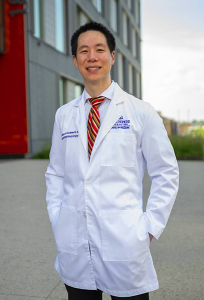This article first appeared in the Wilmer Eye Institute Magazine Summer 2020 Issue.
Though David Guyton, MD, the Zanvyl Krieger Professor of Pediatric Ophthalmology, would never say it himself, he is a bit of a legend around the Wilmer Eye Institute. Often referred to as “the grandfather of strabismus” by those who know and work with him, Guyton has published prolifically, developed practice-changing surgical techniques, and invented new diagnostic technologies that have transformed the field of strabismus care. He is the author of more than 300 peer-reviewed papers and holder of 11 U.S. patents.
Strabismus is a condition in which a patient’s eyes do not maintain correct alignment due to problems with the muscles and tendons that control eye movement. Such misalignment is quite common, affecting 3–5% of all people, usually from childhood. But the surgical correction of strabismus, especially vertical strabismus, has been fraught with variable results in the past, often requiring repeat surgeries. Guyton’s contributions have greatly reduced the need for re-operations.

Guyton, who is now 75, continues to see patients and performs surgery regularly, but he has begun to pursue the task of handing the scalpel to a new generation of strabismus specialists. His leading protégé is Edward Kuwera, MD, an assistant professor of ophthalmology at Wilmer. Guyton says that he admires Kuwera’s interest in strabismus surgery, as well as the younger doctor’s delight in the more quantitative aspects of strabismus care, which allow doctors a precise understanding of each patient’s condition. Guyton also praises Kuwera’s enthusiasm and friendly manner with patients, particularly children.
“Dr. Kuwera was one of the better fellows that we’ve ever had. He likes the mechanisms involved — the physics of strabismus,” Guyton says. “I really look at him as inheriting a lot of these theories and techniques I’ve developed over the years.”
Noting that Guyton’s legacy is unmatched, Kuwera says he considers it an honor to be in his tutelage. In particular, Kuwera notes that Guyton developed new ways to measure torsion (twisting of the eye), and he understands how best to correct those problems with surgery. Kuwera is now an up-and-coming faculty member at Wilmer in his own right, but he and Guyton continue to consult one another on particularly challenging patients.
Daniel Molerio is one patient who benefited from Guyton’s expertise. As a child, he suffered from a difficult case of strabismus that vexed his doctors for years. Molerio had endured at least half a dozen “episodes” of surgery to correct his vision, all of which failed sooner or later. It wasn’t until he was in his 50s that he met Guyton.
“Sometimes people have successful surgeries, and then they backslide. And that’s what had happened to me,” Molerio says. “I went to Dr. Guyton, and he operated on me very successfully.”
Molerio was a direct beneficiary of at least one of Guyton’s innovations: a sliding, removable knot in the surgeon’s suturing technique that allows the surgeon to adjust the amount of correction in the recovery room after the anesthesia wears off, reducing the guesswork that made strabismus surgery so challenging for decades. The patient tells the surgeon precisely where the vision is best, and the surgeon secures the knot at that exact spot.
Molerio’s surgery was more than 10 years ago, and his vision remains strong. He was so grateful for his care that he now supports Guyton’s research and work through yearly gifts of $1,000. Molerio says it’s a sincere and significant expression of his true sentiments.
“Look, I’m a middle-class guy. I decided this was a worthwhile thing, and I could afford it,” Molerio says. “If I can help one child avoid what I went through, it’s worth it. That’s the reason I contribute.”
Topics: Friends of Johns Hopkins Medicine, Johns Hopkins Medicine, Wilmer Eye Institute, Promote and Protect Health